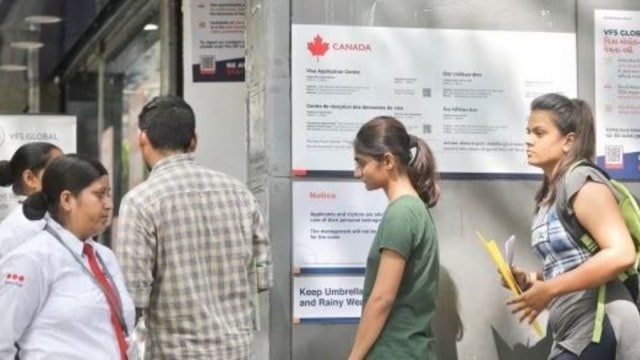

A recent analysis conducted by the Toronto Star, has revealed that nearly half of the international students accepted by Canadian educational institutions face rejections from visa officers.
Nearly 40 percent of student visa applications from India faced rejection due to reasons categorized as “other” or “unspecified,” marking the highest refusal rate among all countries. This data comes from the Investigative Journalism Foundation, a non-profit media organization based in Canada.
India is a leading contributor to international students in Canada, accounting for around 320,000 active study permits by December, as reported by New Canadian Media, a non-partisan outlet serving Canadian immigrants.
International students in Canada often pay five times more fees than the local students and are hence a great revenue generator for both private and public colleges.
But students continue to pay this higher fees as overseas education agents make them believe that studying in Canada is a pathway to getting a permanent residency (PR) of the country.
Recently, the Canadian Immigration Lawyers Association suggested that overseas education agents should fall under the regulation of provinces, and designated learning institutions ought to take responsibility for the activities and conduct of these agents. They propose that institutions should directly employ overseas agents and disclose their personal information, such as names, citizenship, and work locations.
Even though the Canadian government has recently introduced new regulations making it financially more difficult for international students but Lou Janssen Dangzalan, vice-president of the Canadian Immigration Lawyers Association, fears that
some institutions and potential students may seek ways to bypass the new regulations due to the allure of permanent residency. He said some could falsify bank accounts to meet the study permit financial requirements, warning that if such actions persist, Canada’s reputation as an education hub could suffer.
The rejections
The visa data, examined by the Toronto Star, shed light on the inner workings of Canada’s international student system, which has evolved into a significant revenue stream for post-secondary institutions. However, critics, including Immigration Minister Marc Miller, have raised concerns about its integrity, with Miller even likening it to a “puppy mill” being exploited by both educational institutions and individuals seeking work and permanent residence in the country.
During the period between January 1, 2022, and April 30, 2023, the Immigration Department approved 54.3% (470,427) of the 866,206 study permit applicants accepted by Canadian schools. Notably, Ontario, hosting the largest number of designated learning institutions in Canada and being the prime destination for international students, exhibited varying approval rates among different schools.
Public colleges generally experienced higher rejection rates compared to public universities, with private institutions having even higher rates despite comprising less than 10% of the overall applications.
For instance, Conestoga College, the institution with the highest volume of study permit applications nationwide, had an approval rate of 51% out of 61,612 applications. Niagara College (main campuses) and St. Clair had approval rates of 42.6% and 42%, respectively. Loyalist College saw a 47% approval rate overall, but its Toronto Business College campus had a higher rate at 65%.
Experts caution that approval or refusal rates might not directly correlate with the quality of education provided by these institutions. However, these numbers hold significance as Immigration Minister Marc Miller aims to restore trust in Canada’s international student program, emphasizing the need for provinces designating learning institutions to ensure their credibility.
During a recent news conference, Miller highlighted the responsibility of provinces in ensuring that designated institutions deserving of visas are selected, aiming to rebuild confidence in the integrity of the international student program.
The growing international student program has garnered attention due to aggressive recruitment efforts by the post-secondary education sector and unregulated foreign agents. Many migrants view studying in Canada as a pathway to work and permanent residency.
International students and low-paid jobs
Over the last decade, the number of study permit holders in Canada has tripled, reaching nearly 900,000 this year from 300,000 in 2013. These international students contribute around $22 billion to the economy and support 200,000 jobs through their spending and tuition fees. However, due to the ongoing affordable housing crisis and increasing living costs, many international students are facing challenges in finding employment and adequate shelter, leading some to rely on food banks.
With declining provincial funding, educational institutions have turned to international students as a crucial revenue source. Employers have come to rely on the continuous influx of students to fill low-paying positions in various industries.
Education agent and policy researcher Earl Blaney has raised concerns about the immigration system’s strain due to a high rate of study permit application refusals, attributing this to the overwhelming recruitment strategies adopted by many institutions in the last five years. Previously, institutions directly contracted individual recruiters, but now they recruit on a large scale through online platforms, working with numerous sub-agents.
While colleges and universities assess a candidate’s eligibility for a program, sub-agents are tasked with preparing and submitting study permit applications to meet immigration requirements. Blaney highlighted that this approach leads to a surge in low-quality applications being sent to embassies, driven by agents focused on maximizing their revenue.
Blaney noted a lack of direct communication between schools and these agents, leaving administrators unaware of the volume of study permit applications being submitted. Despite higher refusal rates with mass applications, schools are still attracted to this approach as it eventually results in more students being accepted, regardless of the rejection percentage.



